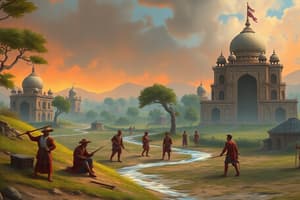Podcast
Questions and Answers
What were the three major drawbacks of the British land revenue system in India?
What were the three major drawbacks of the British land revenue system in India?
The three major drawbacks were: impoverishment of the Indian peasantry, fragmentation of land into small unproductive landholdings, and gradual depeasantisation.
What were the other evils that caused widespread peasant discontentment?
What were the other evils that caused widespread peasant discontentment?
The other evils that caused widespread peasant discontentment were: excessive taxation, erratic fixation of revenue, rigidity in revenue collection, excesses of zamindars, manipulation of moneylenders, and ill treatment of revenue agents.
What was the basic nature of the popular resistance movements against British rule?
What was the basic nature of the popular resistance movements against British rule?
The basic nature of the popular resistance movements was that they were reactions against extreme economic deprivation, often involving physical brutality and ethnic persecution by the government and its agencies.
What were the three broad categories of peasant uprisings during British rule?
What were the three broad categories of peasant uprisings during British rule?
What was the objective of the civil or restorative uprisings that took place between 1765 and 1857?
What was the objective of the civil or restorative uprisings that took place between 1765 and 1857?
How did the nature of peasant uprisings change after 1850?
How did the nature of peasant uprisings change after 1850?
What were some of the religious overtones in the peasant rebellions mentioned?
What were some of the religious overtones in the peasant rebellions mentioned?
Give examples of some major peasant uprisings mentioned in the text.
Give examples of some major peasant uprisings mentioned in the text.
What was lacking in the peasant movements according to the text?
What was lacking in the peasant movements according to the text?
Against whom were the peasant outbursts often directed initially?
Against whom were the peasant outbursts often directed initially?
Flashcards are hidden until you start studying




